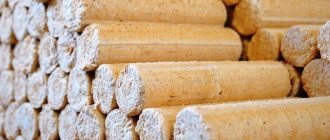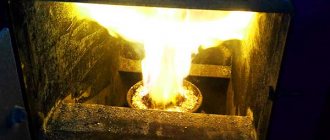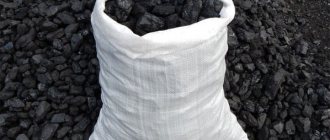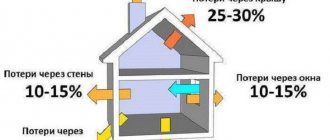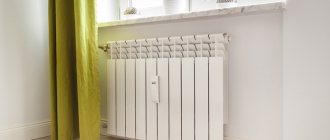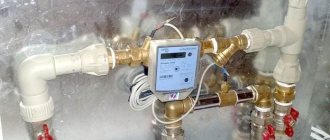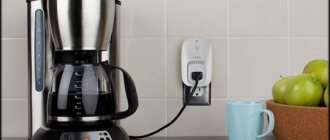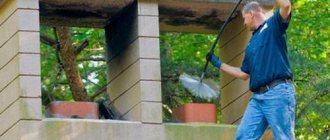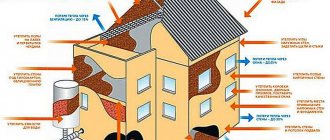Calculating the consumption of pellets for heating in advance is the first task of the owner of a private house who wants to install a pellet boiler. After all, granular fuel is more expensive than firewood, and the price of equipment is higher compared to solid fuel or electric units. One burner for burning pellets is comparable in cost to an entire wood-burning heat generator. To find out the costs of pellet heating, you need to make a simple theoretical calculation, which will be discussed further.
Calculation of pellet consumption - initial data
To find out the theoretical fuel consumption for heating a country house, you need to collect the following initial data:
- the amount of heat load on the heating system of a cottage or country house, expressed in kW;
- Efficiency of the pellet boiler model that you plan to install in your furnace;
- calculated heat of combustion of fuel pellets;
- To get the result in monetary terms, it is advisable to find out the price per ton of pellets in your region of residence.
The most difficult thing is to get a figure for the actual heat load. It consists of heat losses through external walls, roofing, glazing and floors, plus the cost of thermal energy for heating the ventilation air.
The ideal option is to contact a qualified heating engineer for such a calculation, then you will find out the exact figure. Otherwise, you will have to calculate the thermal load and fuel consumption in aggregated ways:
- Based on specific heat consumption per square meter of area. For dwellings in central Russia, it is assumed that in a room with 1 window and one external wall, 100 W of heat per 1 m² will be consumed, with two external walls - 120 W/m², with 2 walls and two windows - 130 W/m².
- The same applies to the volume of premises. The method is used when the ceilings of the rooms exceed 2.8 m. The total heated volume is calculated, the resulting figure is multiplied by 40 W.
Comment. In the calculation example discussed below, the heat load for a private house of 100 m² is conventionally assumed to be 10 kW, since pellet consumption is determined in an abstract building with a pellet boiler from an unknown manufacturer.
The heating unit together with the bunker takes up a lot of space; one of the placement options is in the basement or ground floor. The efficiency
of the heat generator burning wood pellets is indicated in its technical data sheet. If the model and manufacturer have not yet been selected, then for calculations you can take the figure of 80%. Manufacturers leading the rating of heating equipment (for example, Viessmann or Buderus) declare the efficiency of their pellet boilers to be 85%. But these are high-quality and reliable units that are not cheap. More affordable heaters are not as efficient.
The theoretical calorific value of pellets is a known value; it lies in the range of 4.9–5.2 kW/kg, depending on the quality of the fuel and the raw materials from which they are made. If you do not take into account peat granules with high ash content and low heat transfer, then for calculations it is worth taking the average figure - 5 kW / kg.
Heating with pellets: profitable or not, myths and reviews
Let's consider the most common questions regarding the benefits of heating with pellets, their pros and cons:
- Pellets burn better than firewood, is it really possible that something is added to them and this makes them less environmentally friendly? In fact, this is a fairly common and also erroneous opinion. As mentioned above, only harmless raw materials are used for the production of fuel pellets. For example, substances that do not pose a threat to human health are also used as binders for wood waste.
Answering specifically the question of why pellets burn better than firewood, first of all you need to say this:
- The density of fuel granules (pellets) is an order of magnitude higher than that of wood;
- The humidity of pellets is lower.
In addition, the structure of the pellets itself contributes to their better combustion. Do not forget that pellets are burned in boilers specially designed for this purpose, with forced air supply.
How many pellets do you need to heat a house?
- You need much less pellets than firewood to heat the same room. Indeed, heating with pellets shows good results in terms of calorific value. For example, just one kilogram of pellets can produce about 5 kW of heat per hour. Considering that to comfortably heat 10 sq/m you need only 1 kW of heat, then with five kilowatts you can heat a small house of 50 square meters.
- Will pellets burn in a regular stove or boiler? Without a heating boiler with forced air supply into the combustion chamber, it is quite difficult to use fuel pellets for heating. They will burn, but then we can’t talk about any savings, and the combustion of pellets, in this case, will largely depend on how good the draft in the chimney is.
- Pellets can be stored as much as you like, anywhere, and in any conditions. No, this opinion is wrong, and there are a number of strict requirements for storing pellets. Firstly, pellets are afraid of moisture, which, when it comes into contact with them, is successfully absorbed by the granules, after which they also crumble into pieces and become unsuitable for use. Therefore, pellets should only be stored in dry rooms, avoiding sudden temperature changes in them, in order to avoid the formation of condensation.
- 5. Which pellets are better, white or gray? This question is also a common misconception among those who decide to switch to pellet heating.
The color of fuel pellets has nothing to do with their quality, which can only be determined after burning a certain amount of this fuel. And, nevertheless, there are clear visual signs of identifying high-quality and low-quality pellets. So, for example, high-quality pellets should be free of cracks, have a length of at least 7 mm, shine in the light and not crumble if you try to lightly rub them in the palm of your hand.
Rate this article and share the link:
How to calculate pellet consumption
The calculation is carried out in several stages, although in general it is quite simple. Its result should be the average monthly fuel consumption of a pellet boiler during the heating season and the average cost of such heating. For clarity, we will look at an example calculation for a 100 m² house.
The torch-type burner automatically ignites and goes out at the command of the controller, this allows for significant fuel savings
Stage one. First you need to understand how much heat actually enters the heating system when burning 1 kg of fuel pellets. After all, heating equipment is not so perfect as to direct all the energy received to heat the house; part of it will fly out into the chimney. To do this, the combustion heat of the granules should be multiplied by the efficiency of the heat generator, divided by 100:
5 kW/kg x 80% / 100 = 4 kW/kg.
Stage two. For ease of calculation, you need to do the opposite to find out how many pellets you need to burn to obtain 1 kW of thermal energy in real conditions:
1 kW / 4 kW/kg = 0.25 kg.
Stage three. During the heating season, the weather outside changes and the temperature ranges from +10 °C to -30 °C. The average specific heat consumption for the entire season for a house of 100 m² will not be 10 kW, but half as much - 5 kW. Considering that power units are assigned to a time of 1 hour, the heat consumption per day will be:
5 kW/h x 24 hours = 120 kW.
The same, only for a month:
120 kW x 30 days = 3600 kW.
Stage four. Now it is easy to calculate the average consumption of pellets per month for a building of 100 m² during the entire heating season:
3600 kW x 0.25 kg/kW = 900 kg.
If the cold season lasts 7 months, as in Moscow, Russian Federation, then the total amount of fuel pellets for heating a private house with an area of 100 square meters will be 900 x 7 = 6.3 tons. The average monthly consumption of pellets for a house with an area of 150 and 200 m² is determined in the same way; it is equal to 1.35 and 1.8 tons, respectively. Since pellets are sold by weight and not by volume, there is no need to convert this quantity into volumetric units.
Those who are interested in the approximate consumption of wood pellets on average per day can calculate it in this way (for our example):
120 kW x 0.25 kg/kW = 30 kg.
Attention! The average calculated value should not be confused with actual fuel consumption on the coldest and warmest days. In a building of 100 m² it can vary between 15-60 kg of pellets per day.
To get approximate costs for pellet heating in monetary terms, you need to multiply the obtained figures by the price per ton accepted in your region. At prices in the capitals of the Russian Federation and Ukraine, monthly heating costs for a private house of 100 square meters will be:
- for Moscow: 0.9 t x 8500 rub/t = 7650 rub;
- for Kyiv: 0.9 t x 3000 UAH/t = 2700 UAH.
A retort burner is cheaper than a torch burner; it can be installed in a regular TT boiler.
It must be taken into account that we carried out an abstract calculation; in the conditions of Ukraine, financial costs for pellet heating will be lower due to the milder climate.
The best double-circuit pellet boilers
Models of this type can be used simultaneously to ensure the operation of heating and hot water supply systems. They have high power and performance, but also large dimensions.
Zota Maxima 300
5
★★★★★
editorial assessment
100%
buyers recommend this product
The main feature of the model is the increased power level - 300 kW. The operation is controlled using a GSM module and an Internet connection, which allows you to control the system remotely. Non-contact automatic ignition guarantees safe operation of the boiler.
The dimensions of the boiler are impressive - 2x2.1x2.1 m. The fuel combustion time is from 50 hours, since the bunkers have different volumes and provide for the possibility of installing additional sections.
The vertical heat exchanger promotes high efficiency and waste-free combustion. Automatic ash removal ensures convenient maintenance.
Advantages:
- high efficiency;
- ease of control;
- ease of maintenance;
- large volume bunkers;
- uniform flame distribution in the chamber.
Flaws:
- high price;
- big and takes up a lot of space.
Zota Maxima is designed for installation in large areas. It is suitable for work in large workshops or industrial buildings.
Laminox Termoboiler Matic Omnia 32
5
★★★★★
editorial assessment
98%
buyers recommend this product
Vertical heat exchanger tubes and automatic power modulation guarantee a thermal efficiency of more than 93%. The design includes a safety valve, circulation pump, air vent and expansion tank. Boiler power 31.9 kW, dimensions - 1166x700x1403 mm.
The burner is made of stainless steel and equipped with a self-cleaning system. If necessary, the owner can attach an additional pellet hopper to the unit. The software makes it possible to build a unique operating algorithm in accordance with certain days of the week and time.
Advantages:
- automatic ash removal;
- mobile application support;
- precise programming of operating modes;
- large volume of bunker;
- ease of installation;
- high efficiency.
Flaws:
- difficult setup.
Laminox Termoboiler Matic Omnia is a universal solution for long water supply and heating systems. The boiler can be installed in private homes or commercial premises.
READ ALSO
12 best gas boilers
Kiturami KRP 20A
5
★★★★★
editorial assessment
98%
buyers recommend this product
The unit can use pellets with a diameter of 6 to 8 mm and a length of 10-30 mm. Built-in turbulators reduce the fire hazard and provide a coolant temperature of up to 115°C at the outlet in any operating mode.
Elements of the feed mechanisms of the screw and burner are made of sound-absorbing materials. This ensures that the boiler is silent. Maximum power - 24 kW, efficiency 92%.
An electronic thermostat is used to control the temperature of the water in the boiler and the air in the room. It can be installed remotely and has buttons for switching modes: reducing power when there are no people in the house, heating according to a schedule. The automatic pneumatic cleaning system of the heat exchanger eliminates the risk of soot, soot and resin appearing on its walls.
Advantages:
- convenient control;
- safety of use;
- ease of maintenance;
- spacious bunker;
- work on a timer.
Flaws:
- no compressor included.
The heated area of Kiturami is 300 m². Reliable equipment for installation in a cottage, which does not require special attention from the owners.
Tulimax STK 30
4.9
★★★★★
editorial assessment
96%
buyers recommend this product
The model is stable under excessive load and can operate with 20% more power than normal mode. The boiler is equipped with additional heat generation options.
These include electric heating elements, oil burner connections, and a grate for adding logs.
The equipment power is 30 kW, dimensions are 1310x670x935 mm. The volumetric bunker allows the unit to operate continuously for 7 days, providing hot water to the heating and supply systems. Quiet operation contributes to comfortable operation in close proximity to living spaces.
Advantages:
- high power;
- stable work;
- economical fuel consumption;
- noiselessness;
- ease of maintenance.
Flaws:
- complex installation.
Tulimax STK 30 is designed to ensure the operation of branched hot water and heating systems. An excellent choice for installation in industrial buildings or large homes.
Real consumption - user reviews on forums
The results of the theoretical calculation reflect only the general picture and provide an understanding of the order of the financial costs of wood pellets. Indicators published by forum users for real heating with pellets may differ depending on many factors:
- efficiency of the heating unit;
- weather conditions in the region of residence;
- degree of insulation of a residential building;
- quality of the fuel used.
Therefore, homeowners who are inclined to heat their country house with pellets would do well to study reviews from real users and, based on them, collect statistics and draw appropriate conclusions. Here are some of these reviews:
- Vladimir, Sochi, Russian Federation. I heat part of the house with an area of 50 m² with pellets. At an outside temperature of 5-10 degrees below zero, I can withstand +24 °C in the rooms. About 20 kg of first-grade, white granules are consumed per day. The walls are aerated concrete, there is no insulation. I am satisfied with the indicator, I will finish the remaining rooms and will heat the whole house (85 m²) with pellets.
- Alexander, Moscow region, Russian Federation. Warehouse 400 square meters with a ceiling height of 3.6 m, Teplodar pellet boiler with APG-25 burner. When it is minus 30°C outside, the warehouse manages to maintain +10°C. On average, a boiler “eats” 120 kg of pellets per day, and the amount remains almost unchanged when burning different pellets. We tried both white and brown, all the same.
- Valery, Kharkov, Ukraine. I installed a pellet boiler in a one-story house of 140 m², I heat it around the clock, stop once a week and clean for 30 minutes. I keep it at +22 °C inside, the pellet consumption was recorded at an outside temperature of -15 °C - 50 kg per day. The walls are brick with 5 cm foam insulation, the roof is insulated with sawdust, I’m thinking of adding Isover glass wool. In general, it’s acceptable, and it’s hard to give up the comfort; you don’t want to mess around with a regular solid fuel boiler.
- Nikolay, Ochakov, Ukraine. He built a brick house with a heated area of 120 m² (140 square meters in total). The wall thickness is 1 brick (250 mm) plus external insulation with foam plastic 15 cm. My first boiler was a pellet boiler, I am pleased with the results. Over the entire season I used about 4 tons of pellets, I can’t say for sure because I bought more in bags in the spring.
What are pellets
Pellets are fuel granules, and more specifically, they are environmental fuel produced from waste from agriculture and the sawmill industry. Fuel pellets are distinguished not only by their harmless composition, but also by other equally important properties.
For example, the moisture content of pellets is only 8-10%, while for ordinary firewood this figure can reach 50%. The density of pellets is also much higher than wood. But the most important difference between pellets and firewood is their calorific value. It is much larger for fuel pellets.
For example, 1 ton of pellets is capable of releasing about 3.5 thousand kW of heat, which is almost 1.5 times more than when burning wood, and up to 2 times less than the heat produced by coal. Just in terms of their calorific value, pellets give good results, in many ways similar to coal. Actually, this is where the no less common name for fuel pellets, such as “biochar,” came from.
conclusions
If you analyze the reviews and collect more statistics, it turns out that the estimated consumption of pellets for heating is not too different from the real one. If initially the calculation was made according to an enlarged scheme, the results are comparable to fuel consumption in a poorly insulated private house. When you have real indicators of the heat load, then you can calculate the financial costs of pellet heating quite accurately.
When calculating costs, do not forget about the electricity consumption of the boiler, for which you also pay money on the meter. It must be taken into account, because the power consumption of the auger motor, electric ignition device and controller can reach 400-500 W/h, which is quite significant. It can be supplemented by the power of an additional screw conveyor, if you have one installed to move pellets from the storage to the bunker.
